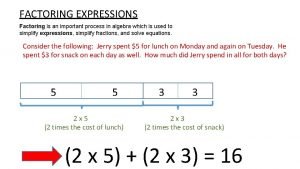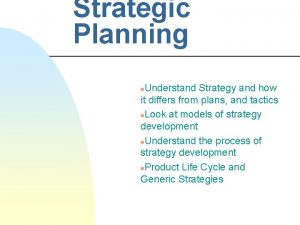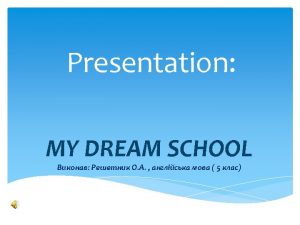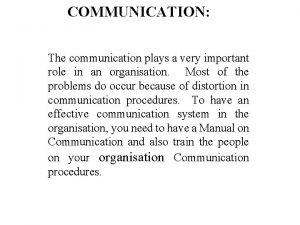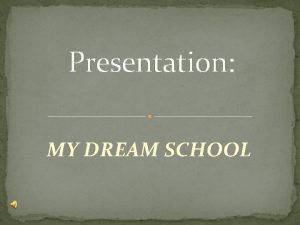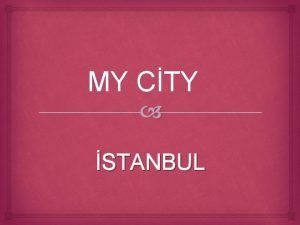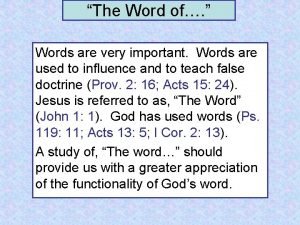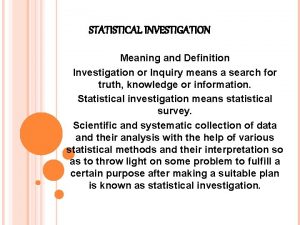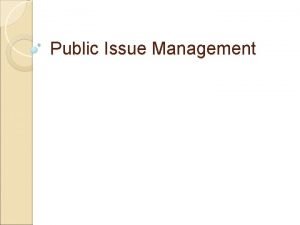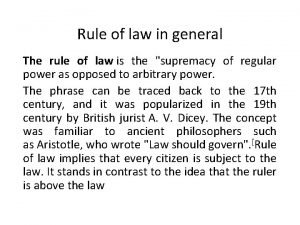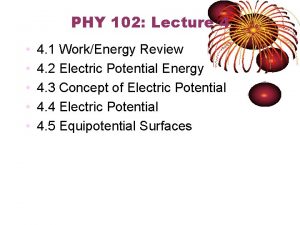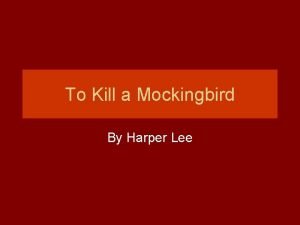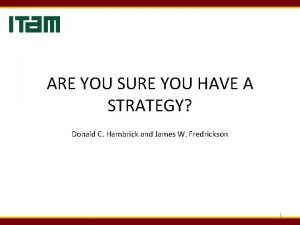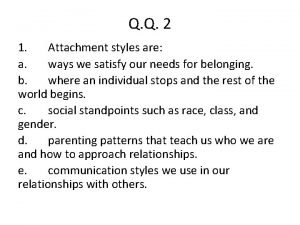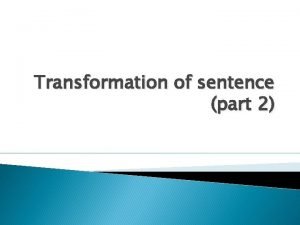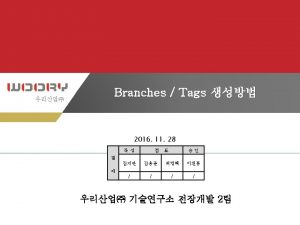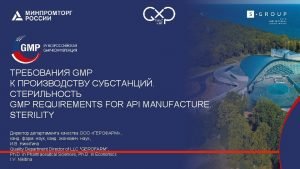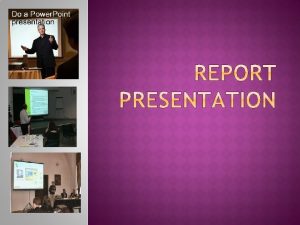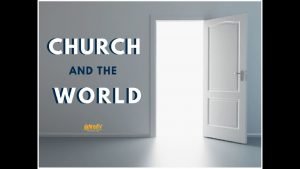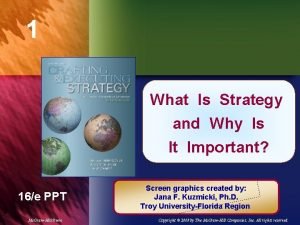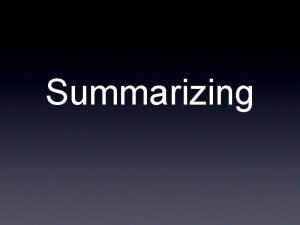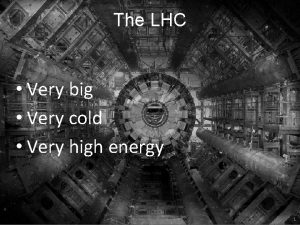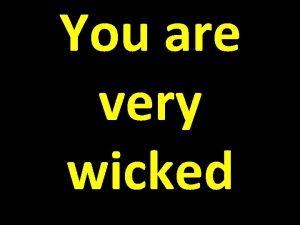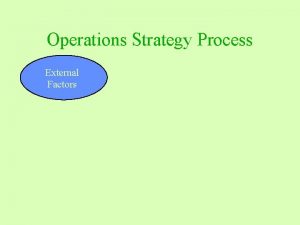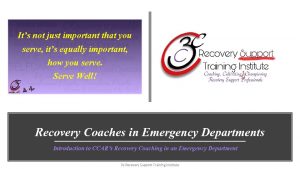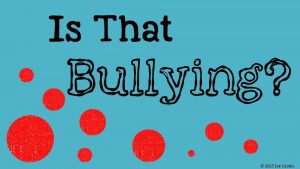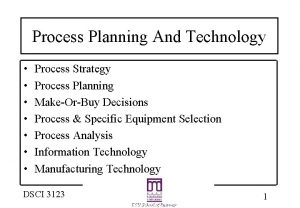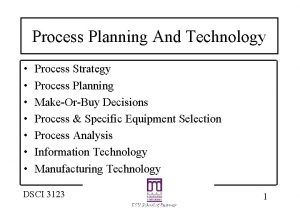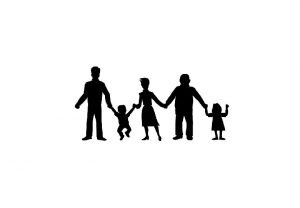Strategy process Its very important you understand this















































- Slides: 47

Strategy process Its very important you understand this and its limitations/underpinning theory and how it connects to practice.

A view of the strategy process

Its worth noting…. • Make sure you can provide a deep and detailed understanding of the ‘process of strategy’ • Make sure you can articulate its connection to the schools of thought and be able to show strengths and limitations • Can you articulate in detail each aspect of the strategy process? • You should also remain sensitive to how all this connects to organisations in the BE • Do not rely on me being right! – check it all out for yourselves through further reading. Strive for depth, connections and academic rigour • Can you make an argument for which school your particular process reflects and reinforces.

Lets take a further look at Strategic Analysis In groups, tell me what the point of a mission statement is and how this connects with vision, purposes, goals, policies and objectives

Strategic analysis: Easy enough! Vision Environmental analysis Organisational analysis Objectives Events Strategic history Strategic analysis Current strategy 1. If only it was as simple as this! 2. The range of activities, concepts and techniques that facilitate this analysis are breathtaking in their number and scope

Strategic analysis: tools, techniques and issues • There are ways to define, develop, communicate and interrelate – – – Vision Purpose Mission (statement) Goals Policies Objectives • Analyse historical accounts of strategy • Analyse past, present and potential future events

Strategic analysis: tools, techniques and issues • Assess the nature of the environment (BPEST) • Assess the influence of environment on the organisation (historical analysis as well) • Analyse the competitive environment from a power perspective (Porter’s five forces) • Analyse and seek to understand the organisations competitive position relative to others

Strategic analysis: tools, techniques and issues • Analyse and seek to understand the lifecycle of the market(s) the organisation operates within • Do a strategic group analysis to determine the strategy of others (prisoners dilemma) • Analyse the segmentation of the market • Do a full SWOT analysis • Conduct a resource audit on the organisation

Strategic analysis: tools, techniques and issues • Conduct a value chain analysis to link resources to strategic performance • Conduct a resource utilisation analysis to determine how resources are actually being deployed • Conduct an analysis on the effectiveness of the organisation in delivering value

Strategic analysis: tools, techniques and issues • Assess or analyse the effectiveness of control (our structure) on delivering performance – to centralise or decentralise this is the question • Ditto – can control of resources outside the industry allow the company to leverage more value

Strategic analysis: tools, techniques and issues • Historical analysis of how resources have been deployed in the past and how effective these strategies were • Analyse the performance of the organisation against the industry norms • Benchmark across other industries to determine the scope for change and strategy • Analyse the balance of resources an organisation owns or controls – is the organisation balanced enough to be flexible?

Strategic analysis: tools, techniques and issues • Conduct a portfolio analysis to see if the company is in a good position to capitalise on market growth in markets where they hold a large share • Analysis to forecast the future – scenario planning • I could go on……but I think you get the general idea…………its not simple! • A lot of these analysis may be conducted by consultants on behalf of the organisation

Strategic analysis • I cannot possibly cover all the ground relating to these techniques • Indeed, it would not be to your benefit for me to do so. • You should focus on a select number of tools, techniques and forms of analysis that you think are relevant to organisations in the BE. • Make sure you can explain why they are relevant. • Make sure you can connect the analysis tools and techniques to both a school of thought and practice in the BE

Hmmm… • Limitations and issues regarding Strategic Analysis: – – – Bounded Rationality? Prisoners Dilemma? Emphasis on Explicit Knowledge? Risk inherent in forecasting? Emphasis on measurements/performance metrics and numbers • Should you do it anyway? Maybe it provides: – – – Sense of comfort The illusion of control A way to manage risk Social cohesion A sense of purpose – despite the above limitations • Knowing what you already know, would you do it anyway?

Vision Objectives Strategic analysis Vision, Mission, Purpose, Goals, Objectives

Vision Overview Objectives • Ultimately developed from the strategic analysis itself but…………current situation informs the analysis • They could possibly be implicit yet, this is unlikely in a large organisation • Develop and change over time • Remain flexible to reflect dynamic evolution of strategy • They ultimately provide something very useful to the organisation – tell me what this is. – – Strategic analysis Marketing? Measures Motivation Something for employees to rally around Cole (1997)

Vision Process of setting or reviewing • Messy – – Who to involve? Top down or bottom up Reactive or proactive (emergent!) People are busy! Too busy fire fighting to look to the future! – Have we got all the info necessary to do this? • Generally done away from the organisation – Get away from the pressures of the business – Relaxes people – Focuses people onto what matters Objectives Strategic analysis

Vision, Mission, Purpose (1) Objectives • Vision – Establish a sense of direction – Embodied in a general statement that is typically called the mission statement Strategic analysis • Mission/purpose – Must establish a consensus on the very reason for the company’s existence • • • Why are we here? Where do we want to be? What do we want from this organisation (many types!) What is the organisations role What kind of organisation are we/or do we want to be? Where do we want the company to operate Cole (1997)

Vision, Mission, Purpose (2) Objectives Strategic analysis – The output will be a mission statement • Sets out key parameters related to the previous Q’s • Outlines the scope for behaviour in the organisation • Statement should be robust enough to stand the test of time • Will be a public statement – – – For customers For the ‘city’ For the shareholders For the employees For the other managers For the union Cole (1997)

Vision, Mission, Purpose (3) Objectives – Mission Statement acts as a central conduit that should bring all those interested parties together – Designed to motivate as well as communicate – It is ultimately strategic managers responsibility – These managers will be judged in the future by reference to this statement – Notably, so too will the organisation by interested parties Strategic analysis • One of the biggest dangers of Mission statement is making them too broad! – See Dilbert's mission statement generator at http: //www. dilbert. com/comics/dilbert/games/career/bin/ ms. cgi – http: //www. netinsight. co. uk/portfolio/mission/missgen. a sp Cole (1997)

Mission statements Our mission is to make tomorrow a better place 1 We will do this by being the leader 2 in integrated solutions for infrastructure, building and services 3, and by acting according to our values 4 of openness, innovation, mutual dependency, collaboration, sustainable profitable growth and professional delivery. This statement has a predominantly marketing spin! 1. Very broad statement that leads us to believe the company cares 2. Definitive and aspirational statement to the market, employees and shareholders 3. Clearly outlines what is being delivered and where 4. Highlights the organisations values OR their aspirational values for all to see and be convinced by In trying to engage too many stakeholders it runs the risk of becoming meaningless

Vision Goals (strategic aims) Objectives Strategic analysis • More detailed and focused statements than mission • They outline intent related to the critical aspects of the business (the core business) • They concentrate on: – – – The use of resources The use of people/skills/knowledge The use of technology The use of new managerial initiatives The application of financial parameters • They may or may not be made public • Needs to be underpinned by an understanding of what the company is good at • Needs to be related to the vision/mission Cole (1997)

Vision Policies Objectives • Broadly shape organisational conduct • States the key values of an organisation – – – Strategic analysis Equal opportunities policy Environmental concern policy Sustainability policy Staff conduct policy Staff appraisal policy Safety policy • Will also tell us what the organisation will NOT do • Likely to be public documents Cole (1997)

Vision Objectives Strategic • Synonymous with targets analysis • Relate to the operational units of an organisation • Relate to efficiency and the output of the organisation they should be: – – Capable of being measured! Sensitive to the mission, aims and policies Should be realistic, clear and flexible if need be Extra special care should be taken to ensure that group objectives between groups do not conflict • Less likely to be made public • Can be related to corporate or unit • Can be open (customer satisfaction, provide good lines of communication) or closed (specific and measurable) Cole (1997)

Vision Typical objectives Objectives • Reduce number of staff from 6, 000 to 1, 000 over the next 6 Strategic analysis months • Maintain customer satisfaction at current levels for the next 3 years • Reduce number of suppliers by 70% over the next 2 years • Increase the revenue of the organisation by 25% over the next 3 years • Increase the number of post graduate students by 200% over the next 2 years • Increase capacity for emergency surgery by 40% over the next 5 years • Reduce reliance on the car by 100% over the next 2 years • Reduce alcohol intake by 200% over the next few weeks

A dynamic model Is shaped by and shapes strategic analysis Mission statement: Includes vision, mission, values and purpose 3 -10 years Feedback on performance Vision Objectives Strategic analysis Policy within which we publicise our Values Goals 1 -5 years Objectives: Operational in nature 1 -2 years Adapted from Cole 1997

Answer the following. . • “organisations fail to implement more than 70 percent of their new strategic initiatives” (Miller 2002) • What are the obstacles? • Can you describe a theoretical model • What are the connections between schools of thought and implementation

Implementation “It can be much easier to think of a good strategy than it is to implement it” (Woolridge and Floyd 1990) “Without successful implementation, a strategy is but a fantasy” (Kast and Rosenzweig 1985) Think of new year resolutions!!

Implementation – what could be easier! • “organisations fail to implement more than 70 percent of their new strategic initiatives” (Miller 2002) • What are the obstacles? – – You tell me. Take 10 minutes to make a list Legitimate reasons Focus on the practical and not theoretical – You could think about why you fail to implement your own plans and relate these to construction organisations

Broad contributors to the problem • Focus on formulation rather than implementation – e. g. look at Cole’s book and my lectures – Focuses on formulation – A 6 page chapter on implementation – Do you ever spend time planning and forget about implementing study plans? • There are few agreed upon models of implementation – Too complex to be modelled! (Okumus 2003) – The search for a magic ‘best practice’ bullet is in vain

Broad contributors to the problem • Implementation is frequently viewed separately (Aaltonen and Ivävalko 2002) Implementing strategy Planned strategy • Those that formulate are frequently different to those that implement Emergent strategy – Planning perspective supports separation – Emergent perspective fails to see any distance between them – Others argue that planned and emergent strategies occur together VISION

Broad contributors to the problem • Ultimately change involves people and thus it is NOT a simple linear, predictable process – – – It simply IS NOT easy to control people Strategy does not resonate with practitioners We are challengers and questioners of change We represent barriers and resistance to change We also provide opportunities to change ‘All progress is made through the unreasonable man!’ – We are also the implementers of change – Change may also be implemented by unreasonable man

Common articulated reasons for problems • • • Weak management roles in implementation A lack of communication Lacking commitment to the strategy Unaware or lack of understanding of strategy Unaligned organisational systems and resources • Poor coordination and sharing of responsibilities • Inadequate capabilities and training provided • Competing activities diverted attention away from implementation Taken from Aaltonen and Ivävalko (2002) and Al-Ghamdi (1998)

Common articulated reasons for problems • Uncontrollable environmental factors • Formulators walk away from implementation!! • Formulators and/or implementers left the company • Leadership necessary was absent during implementation • Underestimation of resources required to carry through implementation • Control and monitoring systems inadequate • Lack of definition of key tasks and activities Taken from Aaltonen and Ivävalko (2002) and Al-Ghamdi (1998)

The broad challenge for implementation • To identify what requires to be changed • To consider what is required to make change happen • To monitor what actually changes • To consider the context within which change will occur • To formulate and execute a plan/process for change • To monitor and react to implementation (Pettigrew 1987)

Related bodies of literature • Strategy as Innovation – Invention – Diffusion • Organisational change – 95% of major change programmes fail (within the fortune 1000 companies) – Structure • • – – – – Social structures Incentive structures Organisational structure Market structure Communication Culture Leadership/management style Motivation Delegation and empowerment Organisational learning Human resources management Groups and group behaviour Strategic Management Overlapping Concerns Operational Management Also, see Cole (1997) p 83 for a list of overlapping concerns

Strategy as innovation Concerned with communication in a social system Closely linked to change management Diffusion Conventionally percieved to be the resolution of a socio-technical problem Formulation is all about invention: the invention of strategy. implementation is invention + diffusion Diffusion may capture all theoretical influences and difficulties discussed previously.

Models to guide Implementation You have 10 minutes to discuss then I want you to be in a position to come up and discuss one of these

Diffusion: The seven S’s model Level of change What needs to change • Superordinate goals – impetus for change or act as a binding force – one or more guiding themes of the organisation – represent the shared values crucial to success – may be a binding force during strategic change – can be a catalyst for strategic change and a source of motivation for individuals.

Diffusion: The seven S’s model Level of change What needs to change • Strategy – outlines where the company or business unit should concentrate its forces and compete – sets out the basis on which the company will compete, the direction in which it will develop and the method it will use.

Diffusion: The seven S’s model Level of change What needs to change • Skills – Gap between current and desired – What capabilities do we require to achieve our strategic objectives

Levels of change What levels are there? • Three primary “S’s” determine level of change – Continuation. Additional resources, new skills and unfamiliar tasks are not required – Routine. A small refinement on continuation. Additional resources may be required in the short term – Limited Change. Additional resources required, but it does not require any major organisational change. – Radical change. Involves major change within the organisation. Numerous changes in the organisation’s structure, systems, staff and management styles. – Organisational redirection. Major changes in terms of the industry in which the organisation operates.

Diffusion: The seven S’s model Level of change What needs to change • Structure – We (re)organise to deliver the plan – The way in which the people are organised – Each structure has its merits and demerits • Small firms - simple structures • The machine bureaucracy structure • Divisionalised structure • Professional bureaucracy • Adhocracy

Diffusion: The seven S’s model Level of change What needs to change • Systems – routines or processes which exist in an organisation for the purpose of identifying important issues, getting things done or making decisions – have a very strong influence on what happens in an organisation • Reward systems • Financial systems • Information systems

Diffusion: The seven S’s model Level of change What needs to change • Staff – concerned with the human resources of the organisation in relation to the implementation of the strategy • what resources will a strategy require • do these new resources build on or are they a change from existing • can the new resources be integrated

Diffusion: The seven S’s model Level of change What needs to change • Style – Style is concerned with the management of change – not concerned with the personal styles of managers on a day-today basis but in the way in which they implement the changes

Successfully managing change 1. Is strategic change coherent? 1. Relevant to objectives? 1. Ongoing sensitivity to the environment. 2. Not every aspect of strategy is planned. 2. Consistent with context? 1. The way that change is led must 3. Is it feasible depend on the context in which it 4. Does it make sense? must occur 2. Manage resistance 1. Integrate human resource management policies with their strategic management and its change process 1. Emphasises the importance of translating strategic change into operational language and action
 To understand recursion you must understand recursion
To understand recursion you must understand recursion Factoring is an important process
Factoring is an important process In cement hardening process instants are very important
In cement hardening process instants are very important Very bad to very good scale
Very bad to very good scale Used to express very large or very small numbers
Used to express very large or very small numbers Very little or very few
Very little or very few Receiving table/area
Receiving table/area Very little food
Very little food Generic strategies examples
Generic strategies examples Crafting and executing strategy in strategic management
Crafting and executing strategy in strategic management Sandra templeton big fish
Sandra templeton big fish School is very important
School is very important Radio telex stations
Radio telex stations Communication plays a very important role in
Communication plays a very important role in Smile is very important
Smile is very important Our dream school
Our dream school Very important place
Very important place Hi im a dog
Hi im a dog Very important word
Very important word Example of a news story
Example of a news story From most important to least important in writing
From most important to least important in writing Least important to most important
Least important to most important Statistical investigation definition
Statistical investigation definition 2 types of people media
2 types of people media What are the activities involved in public issue management
What are the activities involved in public issue management We understand you
We understand you Rule of law means
Rule of law means What do you understand
What do you understand Point a
Point a Is being signed
Is being signed To kill a mockingbird book genre
To kill a mockingbird book genre Are you sure you have a strategy
Are you sure you have a strategy The emigree key themes
The emigree key themes When a train increases its velocity its momentum
When a train increases its velocity its momentum Sunny rainy windy snowy
Sunny rainy windy snowy If its square its a sonnet summary
If its square its a sonnet summary Its halloween its halloween the moon is full and bright
Its halloween its halloween the moon is full and bright Its not easy but its worth it
Its not easy but its worth it Slide thank you for your attention
Slide thank you for your attention The views of ____ comprise the generalized other.
The views of ____ comprise the generalized other. What is assertive sentence
What is assertive sentence Thank you for your attention any questions
Thank you for your attention any questions Thank for your attention
Thank for your attention If you are asked to make a very sensitive glass thermometer
If you are asked to make a very sensitive glass thermometer Dear ladies and gentlemen
Dear ladies and gentlemen Very truly i tell you
Very truly i tell you A company strategy and its quest for competitive advantage
A company strategy and its quest for competitive advantage Summarizingthis
Summarizingthis

